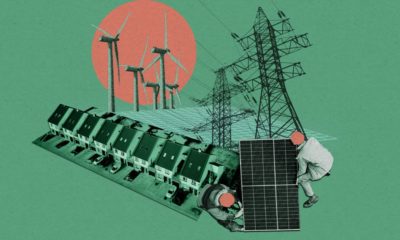Politics
Easy Ways to Save a Few Extra Dollars Each Month in 2023
Published
1 year agoon
By
Drew Simpson
Saving money is a top priority for many people, and with good reason. It can be challenging to make ends meet, especially if you have a lot of financial obligations or are living on a tight budget. The good news is that there are many different ways to save money, and with a little bit of planning and effort, you can find ways to stretch your budget further and reach your financial goals.
Here are some of the best ways to save money in 2023:
1. Create a budget and stick to it
One of the most effective ways to save money is to create a budget and stick to it. A budget is a plan that outlines how you will allocate your income and expenses. By creating a budget, you can identify areas where you may be overspending and find ways to cut back.
To create a budget, start by listing your income and all of your expenses. This can include everything from your rent or mortgage payment to your groceries and entertainment expenses. Once you have a complete list, subtract your expenses from your income to see how much money you have left over.
If you find that you are spending more than you are earning, you will need to find ways to cut back on your expenses. This might involve cutting back on non-essential expenses, such as dining out or subscription services or finding ways to save on your essential expenses, such as by negotiating lower rates for your bills or shopping around for better deals on groceries.
Here are 20 quick ways to create a budget and stick to it:
- Determine your income: To create a budget, you’ll need to know how much money you have coming in each month. This includes your salary, any side income, and any other sources of income.
- Identify your expenses: Next, make a list of all your expenses, including your fixed expenses (such as rent or mortgage payments), variable expenses (such as groceries and gas), and discretionary expenses (such as entertainment and dining out).
- Compare your income and expenses: Once you have a list of your income and expenses, compare them to see if your income is greater than your expenses. If it is, you’re in good shape. If not, you’ll need to find ways to cut back on your expenses or increase your income.
- Set financial goals: Setting financial goals can help you stay motivated to stick to your budget. This might include paying off debt, saving for a down payment on a house, or building up your emergency fund.
- Create a budget plan: Based on your income, expenses, and financial goals, create a budget plan that outlines how you’ll allocate your money each month.
- Track your spending: To make sure you’re sticking to your budget, track your spending to see where your money is going. This can help you identify areas where you may be overspending and find ways to cut back.
- Use cash or a debit card: Using cash or a debit card can help you stick to your budget by making it easier to track your spending and avoid overspending.
- Use budgeting apps or tools: There are many budgeting apps and tools available that can help you track your spending and stay on track with your budget.
- Automate your budget: Automating your budget can help you stay on track by automatically transferring money into savings or paying bills on time.
- Avoid impulse purchases: Impulse purchases can be a major budget-buster, so try to avoid them as much as possible.
- Shop around and compare prices: Don’t just go with the first offer you receive for a product or service. Take the time to shop around and compare prices to ensure you are getting the best deal.
- Use coupons and discounts: Look for coupons and discounts to save money on your purchases.
- Don’t be afraid to negotiate: Don’t be afraid to negotiate for a lower price on products or services.
- Avoid high-interest credit cards: High-interest credit cards can make it harder to pay off debt and stick to your budget, so try to avoid them as much as possible.
- Avoid unnecessary fees: Fees, such as ATM fees or overdraft fees, can add up quickly and make it harder to stick to your budget. Try to avoid unnecessary fees as much as possible.
- Cut back on non-essential expenses: To create a budget that works for you, you’ll need to cut back on non-essential expenses. This might involve canceling subscription services or cutting back on dining out.
- Find ways to save on essential expenses: Look for ways to save on your essential expenses, such as shopping around for the best deals on utilities or car insurance.
- Use cash-back or rewards credit cards wisely: If you do use a credit card, consider using one that offers cash-back or rewards for your purchases. Just be sure to pay off your balance in full each month to avoid interest charges.
- Enlist the help of a financial advisor: If you’re having trouble creating a budget that works for you, consider seeking the help of a financial advisor.
- Write down everything you spend: You’ll find that the more you write down, the less you’ll want to spend.
2. Pay off Debt
Another effective way to save money is to pay off your debt. High-interest debt, such as credit card debt, can be especially costly, as the interest charges can add up quickly. By paying off your debt, you can save a significant amount of money in the long run.
To pay off your debt, you can consider a few different strategies. One option is to focus on paying off your highest-interest debt first, as this will save you the most money in the long run. Alternatively, you could try the debt snowball method, which involves paying off your smallest debts first and working your way up to your larger debts. This can be a good strategy if you need to see some quick wins to stay motivated.
You may also want to consider consolidating your debt, which involves taking out a single loan to pay off multiple debts. This can help simplify your payments and potentially reduce your interest charges. Just be sure to compare the terms and fees of different consolidation options before you decide on one.
Here are 20 quick ways to pay off debt fast:
- Make a budget: To pay off debt quickly, you’ll need to have a clear plan for how you’ll allocate your income and expenses. Creating a budget can help you identify areas where you may be overspending and find ways to cut back.
- Make more than the minimum payment: To pay off debt faster, make more than the minimum payment each month. The more you pay, the faster you’ll be able to pay off your debt.
- Pay off your highest-interest debt first: To save the most money in the long run, focus on paying off your highest-interest debt first.
- Use the debt snowball method: The debt snowball method involves paying off your smallest debts first and working your way up to your larger debts. This can be a good strategy if you need to see some quick wins to stay motivated.
- Consolidate your debt: Consider consolidating your debt by taking out a single loan to pay off multiple debts. This can help simplify your payments and potentially reduce your interest charges.
- Transfer your balance to a lower-interest credit card: If you have a high-interest credit card, consider transferring your balance to a card with a lower interest rate to save money on interest charges.
- Cut back on expenses: To pay off debt faster, you’ll need to find ways to free up more money in your budget. This might involve cutting back on non-essential expenses or finding ways to save on your essential expenses.
- Increase your income: Another way to pay off debt faster is to increase your income. This might involve taking on additional work, starting a side hustle, or negotiating for a raise at your current job.
- Sell items you no longer need: Consider selling items you no longer need or use to generate additional income to put towards your debt.
- Use windfalls wisely: If you receive a windfall, such as a tax refund or bonus, consider using it to pay off debt instead of spending it on non-essential items.
- Consider a debt management plan: A debt management plan can help you pay off your debt faster by consolidating your payments and negotiating lower interest rates with your creditors.
- Use the debt avalanche method: The debt avalanche method involves paying off your debts in order of highest interest rate to lowest. This can save you the most money in the long run, but may be less motivating than the debt snowball method.
- Seek professional help: If you are having trouble managing your debt on your own, consider seeking professional help from a financial advisor or credit counselor.
- Get a part-time job: Taking on a part-time job can provide additional income to put towards your debt.
- Rent out a room in your home: If you have an extra room in your home, consider renting it out to generate additional income to put towards your debt.
- Use a cash-back or rewards credit card: If you do choose to use a credit card, consider using one that offers cash-back or rewards for your purchases. You can then use the cash back or rewards to help pay off your debt.
- Cut back on non-essential expenses: Consider cutting back on non-essential expenses, such as dining out or subscription services, to free up more money in your budget to put towards your debt.
- Refinance your loans: If you have high-interest loans, consider refinancing them to a lower interest rate to save money on interest charges.
- Get a personal loan: If you have high-interest credit card debt, consider taking out a personal loan at a bank vs a loan shark.
- Sell blood and Plasma Factoids: Every 56 days, up to 6 times a year, you can sell your plasma. It’s not the easiest thing to do but it pays well. You will earn between $30 and $60 per donation session.
3. Save on your monthly bills
Another way to save money is to look for ways to lower your monthly bills. This might involve negotiating lower rates for your bills, such as your rent or mortgage payment, or shopping around for better deals on things like your cell phone or internet service.
You can also look for ways to save on your utilities. This might include turning off lights and appliances when they are not in use, using energy-efficient products, and sealing any drafts in your home to reduce your heating and cooling costs.
Here are 20 quick ways to save money on monthly bills:
- Shop around and compare prices: Don’t just go with the first offer you receive for a service or product. Take the time to shop around and compare prices from multiple providers to ensure you are getting the best deal.
- Negotiate lower rates: Don’t be afraid to negotiate lower rates for your bills. Contact your service providers and ask if they can offer you a better deal.
- Switch to a cheaper cell phone plan: If you’re paying a high price for your cell phone plan, consider switching to a cheaper provider or a plan with fewer features.
- Shop for a lower rate on your home or car insurance: Insurance rates can vary significantly between different providers, so it’s worth shopping around to find the best deal.
- Cut back on your cable or satellite TV service: Do you really need all those channels? Consider canceling your cable or satellite TV service and switching to a streaming service instead.
- Use energy-efficient products: Using energy-efficient products can help you save on your monthly utility bills. Look for Energy Star-certified products, which are designed to be more energy-efficient.
- Use LED light bulbs: LED light bulbs are more energy-efficient and can help you save on your monthly electricity bill.
- Unplug appliances and electronics when not in use: Appliances and electronics can still use energy when they are turned off but still plugged in. Unplugging them can help you save on your energy bill.
- Lower the temperature on your water heater: Setting your water heater to a lower temperature can help you save on your monthly energy bills.
- Install a programmable thermostat: A programmable thermostat can help you save on your monthly energy bills by allowing you to set the temperature to adjust when you are away or asleep automatically.
- Check for leaks: Leaks in your home can increase your water bill. Check for leaks and repair them promptly to save money.
- Install low-flow showerheads: Low-flow showerheads can help you save on your monthly water bill by using less water.
- Don’t leave the water running: Turn off it when you are not using it, such as while brushing your teeth or washing dishes.
- Use the dishwasher and washing machine only when full: Running these appliances with a full load can help you save on your monthly water and energy bills.
- Shop for a cheaper internet service provider: If you’re paying a high price for your internet service, consider switching to a cheaper provider or a plan with fewer features.
- Use public transportation or carpool: If you have a long commute to work, using public transportation or carpooling can help you save on your monthly gas bill.
- Walk or bike instead of driving: If you have a short distance to travel, consider walking or biking instead of driving to save on gas.
- Buy a fuel-efficient car: If you are in the market for a new car, consider a fuel-efficient model to save on gas costs.
- Shop around for a lower rate on your credit card: Credit card rates can vary significantly between different providers, so it’s worth shopping around to find the best deal.
- Use cash or a debit card instead of credit cards: Credit cards can be tempting, but they often come with high-interest rates. Cash or debit cards can help you save on interest charges and avoid overspending.
4. Cut back on non-essential expenses
Another way to save money is to cut back on non-essential expenses. This might include things like dining out, subscription services, or expensive hobbies. By cutting back on these types of expenses, you can free up more money in your budget to put toward your financial goals.
Here are 20 quick ways to cut back on non-essential expenses:
-
- Cancel subscription services you don’t use: If you have subscriptions to services you don’t use or need, consider canceling them to save money.
- Eat out less: Dining out can be a major expense, so try to eat out less and cook at home instead.
- Cut back on non-essential shopping: Avoid making unnecessary purchases and stick to a shopping list when you do shop to avoid overspending.
- Cut back on entertainment expenses: Consider free or low-cost entertainment options, such as watching a movie at home instead of going to the theater.
- Cancel gym memberships you don’t use: If you have a gym membership but rarely go, consider canceling it and finding alternative ways to stay active.
- Shop around for a cheaper cell phone plan: If you’re paying a high price for your cell phone plan, consider switching to a cheaper provider or a plan with fewer features.
- Cut back on expensive hobbies: Consider cutting back on expensive hobbies or finding more affordable alternatives.
- Cancel unnecessary memberships: If you have memberships to organizations or clubs that you don’t use or need, consider canceling them to save money.
- Cut back on non-essential travel: While travel can be a fun and enjoyable experience, it can also be a major expense. Consider cutting back on non-essential travel or finding more affordable options.
- Cut back on non-essential entertainment expenses: Consider cutting back on non-essential entertainment expenses, such as going to concerts or sporting events.
- Use a cash-back or rewards credit card: If you do choose to use a credit card, consider using one that offers cash-back or rewards for your purchases.
- Cut back on luxury items: Consider cutting back on luxury items, such as designer clothing or expensive jewelry, to save money.
- Cut back on unnecessary insurance: If you have insurance coverage that you don’t need or use, consider canceling it to save money.
- Use apps or websites to find deals: There are many apps and websites that can help you find deals on non-essential expenses and other items. Check out sites like Groupon or Coupons.com to find discounts on your purchases.
- Cut back on expensive haircuts or salon treatments: Consider cutting back on expensive haircuts or salon treatments and opt for more affordable options.
- Cut back on expensive beauty products: Consider cutting back on expensive beauty products and opt for more affordable alternatives.
- Cut back on non-essential car expenses: Consider cutting back on non-essential car expenses, such as car washes or unnecessary car repairs.
- Cut back on non-essential home improvement projects: While home improvement projects can be enjoyable, they can also be a major expense. Consider cutting back on non-essential projects to save money.
- Cut back on expensive gifts: Consider cutting back on expensive gifts and opt for more affordable options.
- Use cash or a debit card instead of a credit card: Credit cards can be tempting, but they often come with high-interest rates. Using cash or a debit card can help you save on interest charges and avoid overspending. This tip could and should be added to every section in this article.
5. Cut back on non-essential expenses
Groceries can be a major expense, and finding ways to save on them can make a big difference in your budget. One way to save on groceries is to make a shopping list and stick to it. This can help you avoid impulse purchases and focus on the items you need.
Here are 20 quick ways to save money on groceries:
- As mentioned above: make a shopping list and stick to it because this will help you avoid impulse purchases and focus on the items you need.
- Buy in bulk: Buying in bulk can often save you money, especially if you purchase items that have a long shelf life. Just be sure to consider whether you will actually use the larger quantities before you buy.
- Shop at discount stores: Discount stores, such as Aldi or Lidl, often have lower prices on their products compared to traditional grocery stores.
- Shop the sales and use coupons: Keep an eye out for sales and use coupons to save on your groceries.
- Buy generic or store-brand products: Generic or store-brand products are often just as good as their name-brand counterparts but at a lower price.
- Buy produce in season: Produce is often cheaper when it is in season, so consider buying in-season produce to save money.
- Buy frozen or canned produce: Frozen or canned produce can be a more affordable option, especially if fresh produce is not in season.
- Buy meat in bulk and freeze it: Buying meat in bulk and freezing it can save you money, as long as you have the freezer space and will use it before it spoils.
- Grow your own produce: If you have the space, consider growing your own produce to save on your grocery bill.
- Shop at farmer’s markets: Farmer’s markets often have fresh produce at lower prices than traditional grocery stores.
- Don’t shop when you’re hungry: It’s easy to make impulse purchases when you’re hungry, so try to shop on a full stomach to avoid overspending.
- Plan your meals: Planning your meals in advance can help you avoid wasting food and save money on your groceries.
- Use leftovers: Don’t let leftovers go to waste. Use them to create new meals or freeze them for future use.
- Use a meal delivery service: Meal delivery services, such as Blue Apron or Hello Fresh, can be a convenient way to save on groceries, as they provide all the ingredients you need for a meal in one package. Just be sure to compare the cost to your local grocery store to ensure you are getting a good deal.
- Shop at a warehouse store: Warehouse stores, such as Costco or Sam’s Club, often have lower prices on their products due to their bulk sizes. Just be sure to consider whether you will actually use the larger quantities before you buy.
- Use cash or a debit card instead of a credit card: Credit cards can be tempting, but they often come with high-interest rates. Again, using cash or a debit card can help you save on interest charges and avoid overspending.
- Avoid pre-packaged, or convenience items: Pre-packaged or convenience items are often more expensive than buying the ingredients separately and making the item yourself.
- Don’t shop when you’re in a rush: When you’re in a rush, you may be more likely to make impulsive purchases or choose more expensive options. Take your time while shopping to make more mindful decisions.
- Use a cash-back or rewards credit card: If you do choose to use a credit card, consider using one that offers cash-back or rewards for your purchases.
- Use apps or websites to find deals: There are many apps and websites that can help you find deals on groceries and other items. Check out sites like Groupon or Coupons.com to find discounts on your purchases.
Get started today.
Published First on Due. Read Here.
Featured Image Credit: Karolina Grabowska; Pexels; Thank you!
Due
Know exactly how much money you will have going into your bank account each month. No tricks, no gimmicks. Simple retirement for the modern day human.
You may like
-


Four ways AI is making the power grid faster and more resilient
-


It’s shockingly easy to buy sensitive data about US military personnel
-


Plastic is a climate change problem. There are ways to fix it.
-


15 Proven Ways to Increase Customer Engagement and Build Loyalty
-


Four Clever Ways to Use Tiered Pricing for Maximum Profit
-


5 Ways to Reduce Customer Churn
Politics
Fintech Kennek raises $12.5M seed round to digitize lending
Published
6 months agoon
10/11/2023By
Drew Simpson
London-based fintech startup Kennek has raised $12.5 million in seed funding to expand its lending operating system.
According to an Oct. 10 tech.eu report, the round was led by HV Capital and included participation from Dutch Founders Fund, AlbionVC, FFVC, Plug & Play Ventures, and Syndicate One. Kennek offers software-as-a-service tools to help non-bank lenders streamline their operations using open banking, open finance, and payments.
The platform aims to automate time-consuming manual tasks and consolidate fragmented data to simplify lending. Xavier De Pauw, founder of Kennek said:
“Until kennek, lenders had to devote countless hours to menial operational tasks and deal with jumbled and hard-coded data – which makes every other part of lending a headache. As former lenders ourselves, we lived and breathed these frustrations, and built kennek to make them a thing of the past.”
The company said the latest funding round was oversubscribed and closed quickly despite the challenging fundraising environment. The new capital will be used to expand Kennek’s engineering team and strengthen its market position in the UK while exploring expansion into other European markets. Barbod Namini, Partner at lead investor HV Capital, commented on the investment:
“Kennek has developed an ambitious and genuinely unique proposition which we think can be the foundation of the entire alternative lending space. […] It is a complicated market and a solution that brings together all information and stakeholders onto a single platform is highly compelling for both lenders & the ecosystem as a whole.”
The fintech lending space has grown rapidly in recent years, but many lenders still rely on legacy systems and manual processes that limit efficiency and scalability. Kennek aims to leverage open banking and data integration to provide lenders with a more streamlined, automated lending experience.
The seed funding will allow the London-based startup to continue developing its platform and expanding its team to meet demand from non-bank lenders looking to digitize operations. Kennek’s focus on the UK and Europe also comes amid rising adoption of open banking and open finance in the regions.
Featured Image Credit: Photo from Kennek.io; Thank you!
Radek Zielinski
Radek Zielinski is an experienced technology and financial journalist with a passion for cybersecurity and futurology.
Politics
Fortune 500’s race for generative AI breakthroughs
Published
6 months agoon
10/11/2023By
Drew Simpson
As excitement around generative AI grows, Fortune 500 companies, including Goldman Sachs, are carefully examining the possible applications of this technology. A recent survey of U.S. executives indicated that 60% believe generative AI will substantially impact their businesses in the long term. However, they anticipate a one to two-year timeframe before implementing their initial solutions. This optimism stems from the potential of generative AI to revolutionize various aspects of businesses, from enhancing customer experiences to optimizing internal processes. In the short term, companies will likely focus on pilot projects and experimentation, gradually integrating generative AI into their operations as they witness its positive influence on efficiency and profitability.
Goldman Sachs’ Cautious Approach to Implementing Generative AI
In a recent interview, Goldman Sachs CIO Marco Argenti revealed that the firm has not yet implemented any generative AI use cases. Instead, the company focuses on experimentation and setting high standards before adopting the technology. Argenti recognized the desire for outcomes in areas like developer and operational efficiency but emphasized ensuring precision before putting experimental AI use cases into production.
According to Argenti, striking the right balance between driving innovation and maintaining accuracy is crucial for successfully integrating generative AI within the firm. Goldman Sachs intends to continue exploring this emerging technology’s potential benefits and applications while diligently assessing risks to ensure it meets the company’s stringent quality standards.
One possible application for Goldman Sachs is in software development, where the company has observed a 20-40% productivity increase during its trials. The goal is for 1,000 developers to utilize generative AI tools by year’s end. However, Argenti emphasized that a well-defined expectation of return on investment is necessary before fully integrating generative AI into production.
To achieve this, the company plans to implement a systematic and strategic approach to adopting generative AI, ensuring that it complements and enhances the skills of its developers. Additionally, Goldman Sachs intends to evaluate the long-term impact of generative AI on their software development processes and the overall quality of the applications being developed.
Goldman Sachs’ approach to AI implementation goes beyond merely executing models. The firm has created a platform encompassing technical, legal, and compliance assessments to filter out improper content and keep track of all interactions. This comprehensive system ensures seamless integration of artificial intelligence in operations while adhering to regulatory standards and maintaining client confidentiality. Moreover, the platform continuously improves and adapts its algorithms, allowing Goldman Sachs to stay at the forefront of technology and offer its clients the most efficient and secure services.
Featured Image Credit: Photo by Google DeepMind; Pexels; Thank you!
Deanna Ritchie
Managing Editor at ReadWrite
Deanna is the Managing Editor at ReadWrite. Previously she worked as the Editor in Chief for Startup Grind and has over 20+ years of experience in content management and content development.
Politics
UK seizes web3 opportunity simplifying crypto regulations
Published
6 months agoon
10/10/2023By
Drew Simpson
As Web3 companies increasingly consider leaving the United States due to regulatory ambiguity, the United Kingdom must simplify its cryptocurrency regulations to attract these businesses. The conservative think tank Policy Exchange recently released a report detailing ten suggestions for improving Web3 regulation in the country. Among the recommendations are reducing liability for token holders in decentralized autonomous organizations (DAOs) and encouraging the Financial Conduct Authority (FCA) to adopt alternative Know Your Customer (KYC) methodologies, such as digital identities and blockchain analytics tools. These suggestions aim to position the UK as a hub for Web3 innovation and attract blockchain-based businesses looking for a more conducive regulatory environment.
Streamlining Cryptocurrency Regulations for Innovation
To make it easier for emerging Web3 companies to navigate existing legal frameworks and contribute to the UK’s digital economy growth, the government must streamline cryptocurrency regulations and adopt forward-looking approaches. By making the regulatory landscape clear and straightforward, the UK can create an environment that fosters innovation, growth, and competitiveness in the global fintech industry.
The Policy Exchange report also recommends not weakening self-hosted wallets or treating proof-of-stake (PoS) services as financial services. This approach aims to protect the fundamental principles of decentralization and user autonomy while strongly emphasizing security and regulatory compliance. By doing so, the UK can nurture an environment that encourages innovation and the continued growth of blockchain technology.
Despite recent strict measures by UK authorities, such as His Majesty’s Treasury and the FCA, toward the digital assets sector, the proposed changes in the Policy Exchange report strive to make the UK a more attractive location for Web3 enterprises. By adopting these suggestions, the UK can demonstrate its commitment to fostering innovation in the rapidly evolving blockchain and cryptocurrency industries while ensuring a robust and transparent regulatory environment.
The ongoing uncertainty surrounding cryptocurrency regulations in various countries has prompted Web3 companies to explore alternative jurisdictions with more precise legal frameworks. As the United States grapples with regulatory ambiguity, the United Kingdom can position itself as a hub for Web3 innovation by simplifying and streamlining its cryptocurrency regulations.
Featured Image Credit: Photo by Jonathan Borba; Pexels; Thank you!
Deanna Ritchie
Managing Editor at ReadWrite
Deanna is the Managing Editor at ReadWrite. Previously she worked as the Editor in Chief for Startup Grind and has over 20+ years of experience in content management and content development.
